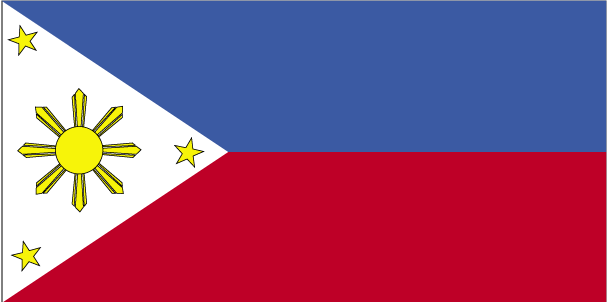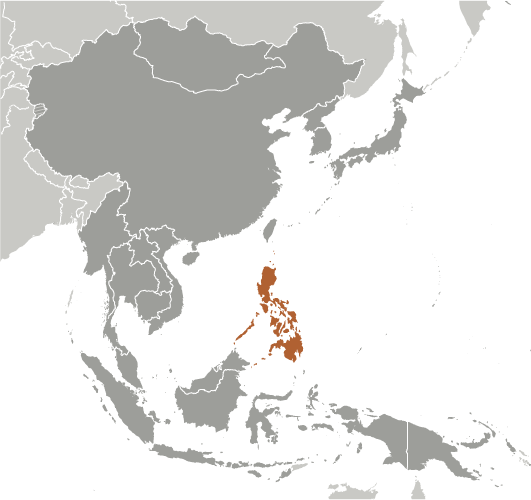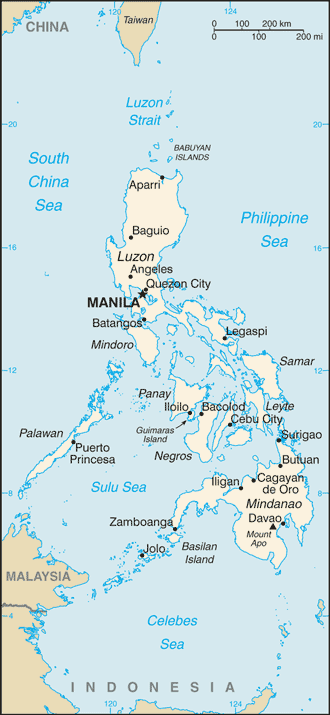
|
|
Advertisements:
EconomyEconomy - overview
Philippine GDP grew 7.6% in 2010, spurred by consumer demand, a rebound in exports and investments, and election-related spending, before cooling to 3.7% in 2011. The economy weathered the 2008-09 global recession better than its regional peers due to minimal exposure to troubled international securities, lower dependence on exports, relatively resilient domestic consumption, large remittances from four- to five-million overseas Filipino workers, and a growing business process outsourcing industry. Economic growth in the Philippines averaged 4.5% during the MACAPAGAL-ARROYO administration (January 2001 - June 2010). Despite this growth, however, poverty worsened during her presidency. The AQUINO administration is working to reduce the government deficit from 3.9% of GDP, when it took office, to 2% of GDP by 2013. The government has had little difficulty issuing debt, both locally and internationally, to finance the deficits. The AQUINO Administration reduced public debt to below 50% of GDP and obtained several ratings upgrades on sovereign debt so that the Philippines is now close to investment grade. However, the lack of government spending, especially on infrastructure, was one of several factors which slowed GDP growth in the second half of 2011, leading the government to announce a stimulus effort and increased public spending on infrastructure in 2012. AQUINO's first budget emphasized education, health, conditional cash transfers for the poor, and other social spending programs, relying mostly on the private sector to finance important infrastructure projects. Weak tax collection, exacerbated by new tax breaks and incentives, has limited the government's ability to address major challenges. The AQUINO administration has vowed to focus on improving tax collection efficiency, rather than imposing new taxes, as a part of its good governance platform. The economy still faces several long-term challenges, including reliance on energy imports and foreign demand for overseas Filipino workers. Gdp (purchasing power parity) World Ranking: 33
$395.4 billion (2011 est.)
$381.2 billion (2010 est.) $354.2 billion (2009 est.) Note Data are in 2011 US dollars Gdp (official exchange rate)
$213.1 billion (2011 est.)
Gdp - real growth rate World Ranking: 102
3.7% (2011 est.)
7.6% (2010 est.) 1.1% (2009 est.) Gdp - per capita (ppp) World Ranking: 160
$4,100 (2011 est.)
$4,100 (2010 est.) $3,800 (2009 est.) Note Data are in 2011 US dollars Gdp - composition by sector
Agriculture 12.8%
Industry 31.5% Services 55.7% (2011 est.) Labor force World Ranking: 15
40 million (2011 est.)
Labor force - by occupation
Agriculture 33%
Industry 15% Services 52% (2010 est.) Unemployment rate World Ranking: 80
7% (2011 est.)
7.3% (2010 est.) Population below poverty line
26.5% (2009 est.)
Household income or consumption by percentage share
Lowest 10% 2.6%
Highest 10% 33.6% (2009 est.) Distribution of family income - gini index World Ranking: 36
45.8 (2006)
46.6 (2003) Investment (gross fixed) World Ranking: 106
19.3% of GDP (2011 est.)
Budget
Revenues $31.4 billion
Expenditures $35.96 billion (2011 est.) Taxes and other revenues World Ranking: 195
14.7% of GDP (2011 est.)
Budget surplus (+) or deficit (-) World Ranking: 79
-2.1% of GDP (2011 est.)
Public debt World Ranking: 55
50.9% of GDP (2011 est.)
52.4% of GDP (2010 est.) Note Data cover central government debt, and includes debt instruments issued (or owned) by government entities other than the treasury; the data include treasury debt held by foreign entities; the data include debt issued by subnational entities, as well as intra-governmental debt; intra-governmental debt consists of treasury borrowings from surpluses in the social funds, such as for retirement, medical care, and unemployment. Debt instruments for the social funds are not sold at public auctions. Inflation rate (consumer prices) World Ranking: 119
4.8% (2011 est.)
4.1% (2010 est.) Central bank discount rate World Ranking: 96
3.8% (31 December 2010 est.)
3.5% (31 December 2009 est.) Commercial bank prime lending rate World Ranking: 123
6.66% (31 December 2011 est.)
7.673% (31 December 2010 est.) Stock of narrow money World Ranking: 53
$34.72 billion (31 December 2011 est.) $29.03 billion (31 December 2010 est.) Stock of broad money World Ranking: 48
$132.5 billion (31 December 2011 est.) $97.35 billion (31 December 2010 est.) Stock of domestic credit World Ranking: 50
$112.6 billion (31 December 2011 est.) $98.22 billion (31 December 2010 est.) Market value of publicly traded shares World Ranking: 37
$202.3 billion (31 December 2010) $130.5 billion (31 December 2009) $85.63 billion (31 December 2008) Agriculture - products
Sugarcane, coconuts, rice, corn, bananas, cassavas, pineapples, mangoes; pork, eggs, beef; fish Industries
Electronics assembly, garments, footwear, pharmaceuticals, chemicals, wood products, food processing, petroleum refining, fishing Industrial production growth rate World Ranking: 135
1.1% (2011 est.)
Electricity - production World Ranking: 43
59.19 billion kWh (2009 est.)
Electricity - consumption World Ranking: 45
54.4 billion kWh (2009 est.)
Electricity - exports
0 kWh (2009 est.)
Electricity - imports
0 kWh (2009 est.)
Oil - production World Ranking: 67
33,110 bbl/day (2010 est.)
Oil - consumption World Ranking: 40
310,000 bbl/day (2010 est.)
Oil - exports World Ranking: 74
60,460 bbl/day (2009 est.)
Oil - imports World Ranking: 31
338,400 bbl/day (September 2010 est.) Oil - proved reserves World Ranking: 65
138.5 million bbl (1 January 2011 est.) Natural gas - production World Ranking: 54
3.15 billion cu m (2009 est.)
Natural gas - consumption World Ranking: 71
3.15 billion cu m (2009 est.)
Natural gas - exports World Ranking: 161
0 cu m (2009 est.)
Natural gas - imports World Ranking: 113
0 cu m (2009 est.)
Natural gas - proved reserves World Ranking: 55
98.54 billion cu m (1 January 2011 est.) Current account balance World Ranking: 30
$7.078 billion (2011 est.)
$8.924 billion (2010 est.) Exports World Ranking: 58
$47.23 billion (2011 est.)
$50.75 billion (2010 est.) Exports - commodities
Semiconductors and electronic products, transport equipment, garments, copper products, petroleum products, coconut oil, fruits Exports - partners
China 21.3%, Japan 14.1%, US 13.9%, Singapore 8.9%, Hong Kong 7.5%, South Korea 4.7% (2009 est.) Imports World Ranking: 50
$62.68 billion (2011 est.)
$61.71 billion (2010 est.) Imports - commodities
Electronic products, mineral fuels, machinery and transport equipment, iron and steel, textile fabrics, grains, chemicals, plastic Imports - partners
China 14.6%, Japan 12.3%, US 9.4%, South Korea 8.4%, Singapore 8%, Thailand 5.6%, Indonesia 4.1% (2009 est.) Reserves of foreign exchange and gold World Ranking: 28
$75.3 billion (31 December 2011 est.) $62.37 billion (31 December 2010 est.) Debt - external World Ranking: 51
$72.27 billion (31 December 2011 est.) $72.34 billion (31 December 2010 est.) Stock of direct foreign investment - at home World Ranking: 64
$25.69 billion (31 December 2011 est.) $24.89 billion (31 December 2010 est.) Stock of direct foreign investment - abroad World Ranking: 56
$6.612 billion (31 December 2011 est.) $6.582 billion (31 December 2010 est.) Exchange rates
Philippine pesos (PHP) per US dollar - 43.313 (2011 est.)45.11 (2010 est.) 47.68 (2009) 44.439 (2008) 46.148 (2007) Fiscal year
Calendar year
Comments
Add a new comment: |
Advertisement
Members area
Philippines (Manila):
 
GPS points from Philippines (Manila)
|
||||||||

 The Philippine Islands became a Spanish colony during the 16th century; they were ceded to the US in 1898 following the Spanish-American War. In 1935 the Philippines became a self-governing commonwealth. Manuel QUEZON was elected president and was tasked with preparing the country for independence after a 10-year transition. In 1942 the islands fell under Japanese occupation during World War II, and US forces and Filipinos fought together during 1944-45 to regain control. On 4 July 1946 the Republic of the Philippines attained its independence. A 20-year rule by Ferdinand MARCOS ended in 1986, when a "people power" movement in Manila ("EDSA 1") forced him into exile and installed Corazon AQUINO as president. Her presidency was hampered by several coup attempts that prevented a return to full political stability and economic development. Fidel RAMOS was elected president in 1992. His administration was marked by increased stability and by progress on economic reforms. In 1992, the US closed its last military bases on the islands. Joseph ESTRADA was elected president in 1998. He was succeeded by his vice-president, Gloria MACAPAGAL-ARROYO, in January 2001 after ESTRADA's stormy impeachment trial on corruption charges broke down and another "people power" movement ("EDSA 2") demanded his resignation. MACAPAGAL-ARROYO was elected to a six-year term as president in May 2004. Her presidency was marred by several corruption allegations but the Philippine economy was one of the few to avoid contraction following the 2008 global financial crisis, expanding each year of her administration. Benigno AQUINO III was elected to a six-year term as president in May 2010. The Philippine Government faces threats from several groups, some of which are on the US Government's Foreign Terrorist Organization list. Manila has waged a decades-long struggle against ethnic Moro insurgencies in the southern Philippines, which has led to a peace accord with the Moro National Liberation Front and on-again/off-again peace talks with the Moro Islamic Liberation Front. The decades-long Maoist-inspired New People's Army insurgency also operates through much of the country. The Philippines faces increased tension with China over disputed territorial claims in the South China Sea.
The Philippine Islands became a Spanish colony during the 16th century; they were ceded to the US in 1898 following the Spanish-American War. In 1935 the Philippines became a self-governing commonwealth. Manuel QUEZON was elected president and was tasked with preparing the country for independence after a 10-year transition. In 1942 the islands fell under Japanese occupation during World War II, and US forces and Filipinos fought together during 1944-45 to regain control. On 4 July 1946 the Republic of the Philippines attained its independence. A 20-year rule by Ferdinand MARCOS ended in 1986, when a "people power" movement in Manila ("EDSA 1") forced him into exile and installed Corazon AQUINO as president. Her presidency was hampered by several coup attempts that prevented a return to full political stability and economic development. Fidel RAMOS was elected president in 1992. His administration was marked by increased stability and by progress on economic reforms. In 1992, the US closed its last military bases on the islands. Joseph ESTRADA was elected president in 1998. He was succeeded by his vice-president, Gloria MACAPAGAL-ARROYO, in January 2001 after ESTRADA's stormy impeachment trial on corruption charges broke down and another "people power" movement ("EDSA 2") demanded his resignation. MACAPAGAL-ARROYO was elected to a six-year term as president in May 2004. Her presidency was marred by several corruption allegations but the Philippine economy was one of the few to avoid contraction following the 2008 global financial crisis, expanding each year of her administration. Benigno AQUINO III was elected to a six-year term as president in May 2010. The Philippine Government faces threats from several groups, some of which are on the US Government's Foreign Terrorist Organization list. Manila has waged a decades-long struggle against ethnic Moro insurgencies in the southern Philippines, which has led to a peace accord with the Moro National Liberation Front and on-again/off-again peace talks with the Moro Islamic Liberation Front. The decades-long Maoist-inspired New People's Army insurgency also operates through much of the country. The Philippines faces increased tension with China over disputed territorial claims in the South China Sea.